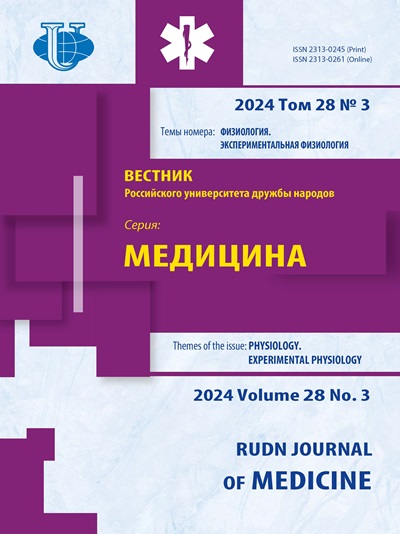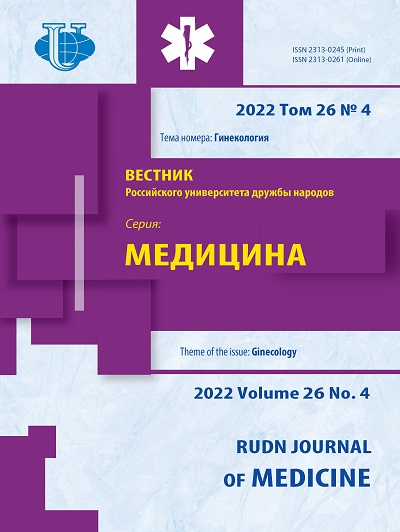Прогнозирование бесплодия у пациенток с лейомиомой матки
- Авторы: Семятов С.М.1, Леффад М.Л.2
-
Учреждения:
- Городская клиническая больница № 64
- Российский университет дружбы народов
- Выпуск: Том 26, № 4 (2022): ГИНЕКОЛОГИЯ
- Страницы: 396-403
- Раздел: ГИНЕКОЛОГИЯ
- URL: https://journals.rudn.ru/medicine/article/view/32993
- DOI: https://doi.org/10.22363/2313-0245-2022-26-4-396-403
Цитировать
Полный текст
Аннотация
Бесплодие является важной социально-экономической проблемой, в связи с тем что запланированное деторождение происходит гораздо позже, чем три десятилетия назад. В последние годы все больше внимания уделяется роли лейомиомы матки в развитии бесплодия. Лейомиома матки - д оброкачественная моноклональная, хорошо отграниченная капсулированная опухоль, происходящая из гладкомышечных клеток шейки или тела матки. Лейомиома матки является наиболее распространенной опухолью матки в репродуктивной возрастной группе, поражающей 20-50 % женщин. С концептуальными изменениями в вопросах брака и деторождения число женщин старше 35 лет с лейомиомой, желающих иметь детей, также значительно увеличилось. Необходимость лечения подслизистых миом широко признана, но миомы других локализаций и размеров продолжают представлять собой клиническую загадку. Целью литературного обзора являлось определение роли миомы матки при прогнозировании бесплодия. Выводы. Установлено, что частота встречаемости лейомиомы матки у женщин репродуктивного возраста составляет в среднем около 40 %, бесплодие ассоциированной с данной патологией встречается у 5-10 % женщин. В 10 % случаев бесплодия лейомиома матки является единственной установленной причиной бесплодия. Лейомиома матки широко распространена среди женщин репродуктивного возраста, и поскольку, женщины продолжают откладывать деторождение, все большему числу пациентов потребуются варианты лечения, сохраняющие фертильность. Лейомиома влияет не только на фертильность, а также на акушерские исходы. У женщин с интрамуральными миомами без деформации полостей наблюдается снижение частоты живорождения на 21 % после экстракорпорального оплодотворения по сравнению с контрольной группой без миомы. Несмотря на прогресс, достигнутый в фундаментальном понимании биологии лейомиомы, роль различных вариантов миом остается предметом для дискуссии. Вопрос об отрицательном влиянии субмукозных узлов на бесплодие на сегодняшний день не вызывает сомнений, а влияние субсерозных и интрамуральных узлов требуют дальнейшего изучения.
Ключевые слова
Об авторах
С. М. Семятов
Городская клиническая больница № 64
Email: Lemin.leffad@gmail.com
ORCID iD: 0000-0002-0582-3618
г. Москва, Российская Федерация
М. Л. Леффад
Российский университет дружбы народов
Автор, ответственный за переписку.
Email: Lemin.leffad@gmail.com
ORCID iD: 0000-0001-6816-3314
г. Москва, Российская Федерация
Список литературы
- Женское бесплодие (современные подходы к диагностике и лечению). Клинические рекомендации. 2021. Министерство здравоохранения РФ. 81 с.
- Миома матки. Клинические рекомендации. Министерство здравоохранения РФ. 2020. 48 с.
- Purohit P, Vigneswaran K. Fibroids and Infertility. Current obstetrics and gynecology reports. 2016;5:81-88. doi: 10.1007/s13669-016-0162-2
- Sevostyanova O, Lisovskaya T, Chistyakova G, Kiseleva M, Sevostyanova N, Remizova I, Buev Y. Proinflammatory mediators and reproductive failure in women with uterine fibroids. Gynecol Endocrinol. 2020;36:33-35. doi: 10.1080/09513590.2020.1816726
- Olive DL, Pritts EA. Fibroids and reproduction. Semin Reprod Med. 2010;28(3):218-27.
- Al-Hendy A, Myers ER, Stewart E. Uterine Fibroids: Burden and Unmet Medical Need. Semin Reprod Med. 2017;35 (6):473-480. doi: 10.1055/s-0037-1607264
- Бадмаева С.Ж., Цхай В.Б., Григорян Э.С., Полстяная Г.Н. Миома матки: современные аспекты этиологии и патогенеза // Мать и Дитя. 2019. T. 76. № 1. С. 4-9.
- Ciebiera M, Włodarczyk M, Słabuszewska-Jóźwiak A, Nowicka G, Jakiel G. Influence of vitamin D and transforming growth factor β3 serum concentrations, obesity, and family history on the risk for uterine fibroids. Fertil Steril. 2016;106(07):1787-1792. doi: 10.1016/j.fertnstert.2016.09.007
- Donnez J, Dolmans MM. Uterine fibroid management: from the present to the future. Hum Reprod Update. 2016;22(6):665-686. doi: 10.1093/humupd/dmw023
- Kim, JJ, Sefton, EC. The role of progesterone signaling in the pathogenesis of uterine leiomyoma. Molecular and cellular endocrinology. 2012;358(2):223-231. doi: 10.1016/j.mce.2011.05.044
- Stewart EA, Cookson CL, Gandolfo RA, Schulze-Rath R. Epidemiology of uterine fibroids: a systematic review. BJOG. 2017;124(10):1501-1512. doi: 10.1111/1471-0528.14640
- Цхай В.Б., Григорян Э.С., Костарева О.В., Бадмаева С.Ж. Миома матки и бесплодие: этиология, патогенез, современные принципы лечения (обзор литературы) // Сибирское медицинское обозрение. 2019. № 4. C. 25-33.
- Цхай В.Б., Штох Е.А. миома матки и репродуктивная функция женщины. Связь миомы матки с бесплодием. Акушерство, Гинекология и Репродукция. 2014. T. 8. № 4. C. 42-47.
- Middelkoop MA, Harmsen MJ, Manyonda I, Mara M, Ruuskanen A, Daniels J, Mol BWJ, Moss J, Hehenkamp WJK, Wu O. Uterine artery embolization versus surgical treatment in patients with symptomatic uterine fibroids: Protocol for a systematic review and meta-analysis of individual participant data. Eur J Obstet Gynecol Reprod Biol. 2021; 256: 179-183. doi: 10.1016/j.ejogrb.2020.11.027
- Толибова Г.Х. Патогенетические детерминанты эндометриальной дисфункции у пациенток с миомой матки // Журнал акушерства и женских болезней. 2018. Т. 67. № 1. С. 65-72.
- Carranza-Mamane B, Havelock J, Hemmings R. Prise en charge des fibromes utérins en présence d’une infertilité autrement inexpliquée. J Obstet Gynaecol Can. 2016;38(12S): S 597-S 608. doi: 10.1016/j.jogc.2016.09.066
- Munro MG. Uterine polyps, adenomyosis, leiomyomas, and endometrial receptivity. Fertil Steril. 2019;111(4):629-640. doi: 10.1016/j.fertnstert.2019.02.008
- Sohn GS, Cho S, Kim YM, Cho CH., Kim MR, Lee SR; Working Group of Society of Uterine Leiomyoma. Current medical treatment of uterine fibroids. Obstet Gynecol Sci. 2018.61(2):192-201. doi: 10.5468/ogs.2018.61.2.192
- Christopoulos G. Vlismas A. Salim R. Islam R. Trew G. Lavery S. Fibroids that do not distort the uterine cavity and IVF success rates: an observational study using extensive matching criteria. BJOG. 2017;124:615-621. doi: 10.1111/1471-0528.14362
- Styer AK, Jin S, Liu D, Wang B, Polotsky AJ, Christianson MS, Vitek W, Engmann L, Hansen K, Wild R, Legro RS, Coutifaris C, Alvero R, Robinson RD, Casson P, Christman GM, Christy A, Diamond MP, Eisenberg E, Zhang H, Santoro N; National Institute of Child Health and Human Development Reproductive Medicine Network. Association of uterine fibroids and pregnancy outcomes after ovarian stimulation-intrauterine insemination for unexplained infertility. Fertil Steril. 2017;107(3):756-762.e3. doi: 10.1016/j.fertnstert.2016.12.012
- Yan L, Yu Q, Zhang YN, Guo Z, Li Z, Niu J, Ma J. Effect of type 3 intramural fibroids on in vitro fertilization-intracytoplasmic sperm injection outcomes: a retrospective cohort study. Fertil Steril. 2018;109(5):817-822.e2. doi: 10.1016/j.fertnstert.2018.01.007
- Van Heertum K, Barmat L. Uterine fibroids associated with infertility. Womens Health (Lond). 2014;10(6):645-53.
- Sunkara SK., Khairy M, El-Toukhy T, Khalaf Y, Coomarasamy A. The effect of intramural fibroids without uterine cavity involvement on the outcome of IVF treatment: a systematic review and meta-analysis. Hum Reprod. 2010;25(2):418-29.
- Vlahos NF, Theodoridis TD, Partsinevelos GA. Myomas and Adenomyosis: Impact on Reproductive Outcome. Biomed Res Int. 2017;2017:5926470. doi: 10.1155/2017/5926470
- Ikhena DE, Bulun SE. Literature Review on the Role of Uterine Fibroids in Endometrial Function. Reprod Sci. 2018;25(5):635- 643. doi: 10.1177/1933719117725827.
- Аганезов С.С., Аганезова Н.В., Мороцкая А.В., Пономаренко К.Ю. Рецептивность эндометрия у женщин с нарушениями репродуктивной функции // Журнал акушерства и женских болезней. 2017. Т. 66. № 3. C. 135-142.
- The Practice Committee of the American Society for Reproductive Medicine. Current clinical irrelevance of luteal phase deficiency: a committee opinion. Fertil Steril. 2015.103(4):27-32. doi: 10.1016/j.fertn-stert.2014.12.128
- Pier BD, Bates GW. Potential causes of subfertility in patients with intramural fibroids. Fertility research and practice. 2015;1;12. doi: 10.1186/s40738-015-0005-2.
- Supermaniam S, Thye WL. Intramural fibroid and fertility - to operate or not. Gynecol Pelvic Med. 2019;2:31. doi: 10.21037/ gpm.2019.11.01
- Navarro A, Bariani MV, Yang Q, Al-Hendy A. Understanding the Impact of Uterine Fibroids on Human Endometrium Function. Front Cell Dev Biol. 2021;9:633180. doi: 10.3389/fcell.2021.633180.
- Justiz Vaillant AA, Qurie A. Interleukin. In: StatPearls [Internet]. Treasure Island (FL): StatPearls Publishing; 2022.
- Tagashira Y, Taniguchi F, Harada T, Ikeda A, Watanabe A, Terakawa N. Interleukin-10 attenuates TNF-alpha-induced interleukin-6 production in endometriotic stromal cells. Fertil Steril. 2009;91(5 Suppl):2185-92. doi: 10.1016/j.fertnstert.2008.04.052
- Посисеева Л.В., Герасимов А.М., Петрова У.Л. Гликоделин в акушерско-гинекологической практике: прошлое, настоящее, будущее // Проблемы репродукции. 2020. 26(3):11-22. doi: 10.17116/repro20202603111
- Галимова Э.Ф., Ахмадуллина Г.Х., Булыгин К.В., Мочалов К.С., Галимов Ш.Н. Гликоделин S в сыворотке крови и эякуляте при идиопатическом бесплодии // Медицинская иммунология. 2015. Т. 17. С. 264.
- Farimani Sanoee M, Alizamir T, Faramarzi S, Saidijam M, Yadegarazari R, Shabab N, Rastgoo Haghi A, Alizadeh Z. Effect of myomectomy on endometrial glutathione peroxidase 3 (GPx3) and glycodelin mRNA expression at the time of the implantation window. Iran Biomed J. 2014;18(2):60-6. doi: 10.6091/ibj.1222.2013
- Borahay MA, Asoglu MR, Mas A, Adam S, Kilic GS, Al-Hendy A. Estrogen Receptors and Signaling in Fibroids: Role in Pathobiology and Therapeutic Implications. Reprod Sci. 2017;24(9):1235-1244. doi: 10.1177/1933719116678686
- Cухих Г.Т., Осипьянц А.И., Мальцева Л.И., Смолина Г.Р., Полозников А.А., Муйжнек Е.Л., Киселев В.И. Аномальное гиперметилирование генов HOXА10 и HOXА11 при бесплодии, ассоциированном с хроническим эндометритом // Акушерство и гинекология. 2015. № 12. С. 69-74.
- Pier BD, Bates GW. Potential causes of subfertility in patients with intramural fibroids. Fertil Res Pract. 2015;1:12. doi: 10.1186/s40738-015-0005-2
- Rackow BW, Taylor HS. Submucosal uterine leiomyomas have a global effect on molecular determinants of endometrial receptivity. Fertil Steril. 2010;93(6):2027-2034. doi: 10.1016/j.fertnstert.2008.03.029
















